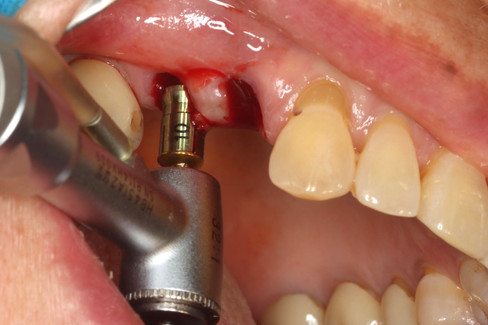One-Stage Immediate ALX Implant Placement With Crestal Sinus Augmentation
- GAO
- Aug 6
- 3 min read
Updated: Aug 21

Case Summary 🔎
Patient Information
Medical History: Osteoporosis
Drug allergy: Loxoprofen
Introduction
Implant placement in the posterior maxilla often presents challenges due to limited bone height and proximity to the maxillary sinus. Recently, immediate implant placement after tooth extraction has become increasingly popular. It offers several advantages, including shorter treatment time, preservation of alveolar bone, and improved patient comfort.
This case describes the immediate placement of two implants in the posterior maxilla (#14 and #15) following tooth extraction. At site #15, a crestal sinus elevation was performed due to insufficient residual bone height. The ALX system was used for implant placement, providing excellent primary stability. This enabled early functional loading within just one month after surgery. This case highlights a predictable and efficient approach for managing posterior maxillary sites with simultaneous extraction, sinus grafting, and accelerated prosthetic restoration.
Treatment Plan
Extraction of #14 and #15 was planned on the same day as implant placement.
At site #15, a crestal approach using the SCA Kit was necessary due to insufficient vertical bone height.
Sinus grafting and implant placement were performed simultaneously.
Early loading was planned, aiming to deliver the final restoration 4 weeks post-operatively.
Case Presentation
1️⃣ Pre-Op
Tooth #15 was located in close proximity to the maxillary sinus floor, and residual bone height was insufficient—indicating the need for sinus augmentation.
The loss of lamina dura indicated a hopeless prognosis, supporting the decision for extraction and immediate implant placement.
2️⃣ Surgery - ALX Implant System
S-reamer with a 10mm stopper used at site #15 to safely control the depth during crestal sinus elevation.
The initial osteotomy was performed using a ø2.2 twist drill as the first step in the sequential drilling protocol.
Final osteotomy performed with a ø3.5 twist drill in preparation for placement of ø4.5 ALX fixture.
Bone density: D332
Fixture size: ALXIT 4510 30
Bone density: D333
Fixture size: ALXIT 4512 30
Scan bodies were placed on both implants for intraoral digital scanning on the day of surgery.

3️⃣ Post-Op

4️⃣ Prosthetics
The final restoration was delivered one month after surgery. Occlusal contacts were carefully evaluated and adjusted to ensure proper function.
The final prosthesis showed satisfactory esthetics, proper occlusal contact, and healthy peri-implant soft tissue.

5️⃣ Conclusion
This case demonstrates the clinical predictability of immediate implant placement combined with crestal sinus augmentation and early loading.
Even in medically compromised patients—such as those with osteoporosis—favorable outcomes can be achieved when proper planning and implant selection are ensured.
In this case, the ALX implant system provided excellent primary stability at both sites, which enabled early functional loading just one month after surgery. This predictable stability was a key factor in achieving efficient treatment flow and a successful prosthetic outcome.































First of all, congratulations on your case. However, I'm curious about the long-term follow-up of this case. What will be the long-term success rate of loading after one month, following adequate primary stability?